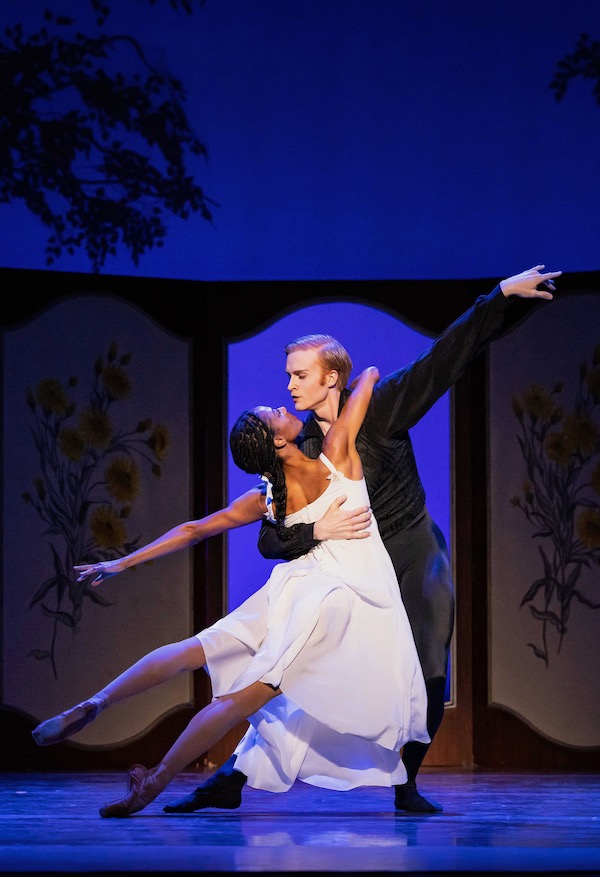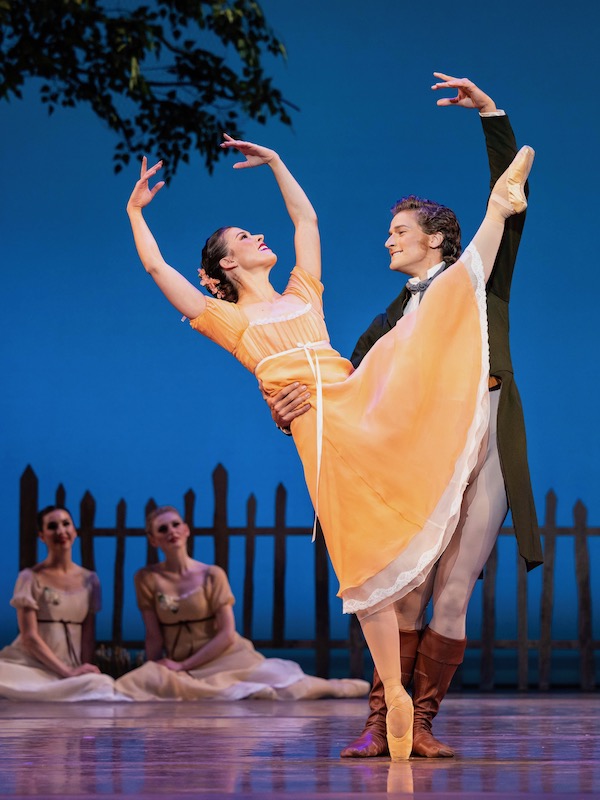Ballet West brings fresh dramatic life and nuance to Cranko’s timeless “Onegin”

Ballet West opens their 59th season with a lauded classic, John Cranko’s setting of Alexander Pushkin’s 19th century verse novel, Eugene Onegin.
This well-known tale of love offered, rejected and offered and rejected again—made into a celebrated opera by Tchaikovsky, which here supplies the music (arranged by Kurt-Heinz Stolze)—serves as a fitting base for a dramatic ballet. The tale among the well-heeled Russian nobility features lavish country parties, rapturous declarations of romance, a duel and two separate instances where someone tears up a love letter in the sender’s face.
Cranko’s Onegin impresses in that it extends past the soap opera melodramatics—ofear not, there are still plenty—and explores the potential for choreography to mirror the complexity of characterization and narrative found in its literature source.
Through the ballet’s four main characters—Onegin (Adrian Fry), his complicated love interest Tatiana (Katlyn Addison), her sister Olga (Chelsea Keefer) and her betrothed, Lensky (Jordan Veit)—the ballet highlights exaggerated distinctions in movement to conjure the power of archetype. We are first introduced to Olga, who flounces around in rapid twirls and jubilant bounces. When Lensky enters, his stoicism counters her almost childlike joviality. He, the hero, glides across the stage in big arcs, emphasizing his muscularity and provincial poise while she, the maiden, concerns herself with beauty and playing frivolous games with her friends.
More significant than these back-to-back gender dichotomies is their eventual merger. The ballet’s first pas de deux finds these opposing styles in concert, not contrast. The set piece begins and ends with Olga in Lensky’s arms, the latter gently guiding the former’s arms into his curvaceous movements. The dancers then open up, making use of the whole floor as they leap into each other’s arms, pausing often for lingering glances and embraces. Where the ballet’s other romantic duets (mostly Tatiana vying for an unwilling Onegin or vice versa) emphasize the lack of connection and impossibility of such, here we see a true, simple romance.
In the two leads, cast with BW’s principal artists, Cranko’s choreography offers more nuanced and varied settings. At any point in the ballet, Onegin stands as the height of melodrama and ironic exaggeration. In his introduction, he moves with pompous, showy movements, pausing amid his acrobatics as if to metaphorically look himself in the mirror. The arrogant sense of importance that Fry laces into every movement—happiness as pride, sadness as self-pity—has a wit akin to portrayals of the bourgeois in a dry, British satire. Later, during his provocations and flirtations in Act II, these airs melt away into juvenile antics, showing the always sinister and immature origins of Onegin’s glut of intellectual pride. In all configurations, hats off to Cranko and Fry for creating a character so utterly unlikable in his forced angularity and self-directed infatuation.
Tatiana remains the only of the four leads who escapes this choreography-as-caricature. Both as a result of the choreography and Addison’s measured performance, she feels more grounded, nearer to palpable human emotion. In the first act’s second scene, where her infatuation with Onegin builds to dream-induced raptures, the way she falls into the phantom Onegin’s arms and allows him to sweep her across the floor isn’t a languid profession of submission, but a deep, heavy pull into romance’s comforts. In how easily she instills trust in Onegin to literally fling her body around, we see Tatiana’s desire unfold—to be held, carried, lifted and caressed as only the Onegin of her dreams does.
When the romantic tables flip in the ballet’s finale, these differences in stability reemerge. As Onegin dances around the St. Petersburg ballroom in Act III, years after the ballet’s initial story, he bitter
ly deflects suitors and (finally) yearns for Tatiana. His rapid movements—quick jolts between adoration, dismissal and anguish—denote anger, resentment, infantile frustration. When Tatiana turns him away once and for all, he scurries away frightened and embarrassed.
In direct contrast, Tatiana stands center stage, arms dangling and posture limp as she cries into the back of the theater with deep pathos under the falling curtain. When Onegin weeps, he weeps in a crumpled pile for himself, for his hubris; when Tatiana weeps, she weeps for something more abstract, for the cruelness of fate that drapes around her cold and empty boudoir.
In a show full of exaggerations and hyper-characterizations, moments such as the finale offer important glimpses into a less cynical humanism. Onegin’s peak of this sentimentality arrives near the end of the second act, where a betrayed and heartbroken Lenksy prepares to duel his best friend for moving in on his fiancée. Veit drops the Gaston-esque gallantry he had donned to this point, staring his impending death in the face with a chilling mix of hesitation, acceptance and exhaustion. Against dim, blue lighting and a bare set of trees, he slides across the floor as if he’s pacing in anxiety. Often moving in elongated strides, Veit drags his limbs around at a funeral pace; at some moments he stumbles, running up against his own mortality in a quiet panic. Despite its framing as a subsect of a grander romantic narrative, Veit’s solo here feels like a dramatic and emotional highpoint. Any sense of caricature vanishes in place of a moment of critical existentialism.
That Cranko’s choreography and its realization by the Ballet West dancers can spark such strong emotions—not just in its dramatics, but in its characters’ nuanced reactions to them—speaks to his sustained an well-deserved reputation in American 20th-century choreography. Onegin looks toward a psychological and narrative nuance that still feels fresh nearly 70 years after the first production in 1965. Without abandoning the bombast, here Ballet West celebrates the less-common virtue of subtlety.
Ballet West’s Onegin runs through October 29. balletwest.org

